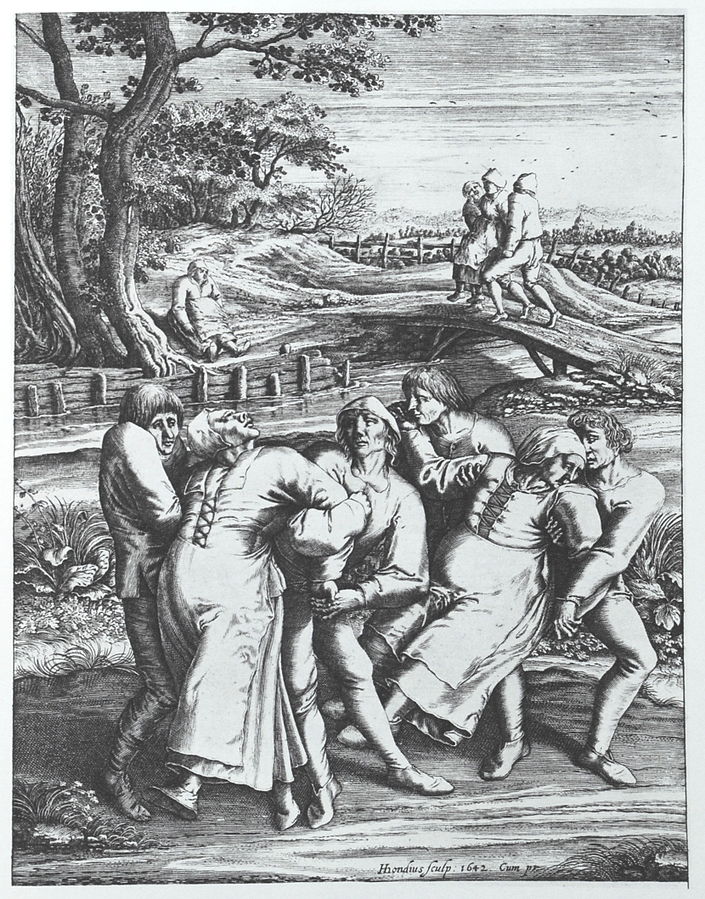Outbreak of the Dancing Sickness in Aachen, Germany, 1374
 |
| "Dance at Molenbeek" by Pieter Brueghel the Younger. |
They danced until they dropped.
A very strange phenomenon took place in Europe in the 13th through the 17th centuries. People danced. Hundreds of them, sometimes thousands, involuntarily and uncontrollably. They danced until they dropped from exhaustion, or until their feet were bloody, or until they died. Sometimes they sang, shrieked, begged for deliverance. Sometimes they had visions.
There were reports of all types of bizarre behavior among the afflicted. Some engaged in lewd behavior. Some could not stand the color red, or pointed shoes. There were reports that some dancers enjoyed having their feet hit. Many of them experienced visions, or achieved a state of ecstasy.
No one today knows what caused this behavior, but it seems to have stopped, suddenly, in the 17th century. The outbreaks started small, with only a few people. More people would join them. Sometimes musicians were provided by the town, in the belief that music would calm the sufferers or exorcise the demons. Usually it just led to more dancing.
One of the best-documented cases is the one which occurred in Aachen, Germany, beginning on June 23, 1374. There was no widespread agreement, even then, as to the cause. It was sometimes called the "dancing plague" and it was believed that it was sent by St. John, or by St. Vitus, or that, if the saints hadn't caused it, at least they could cure it. Consequently, the ailment was also known as "St. John's Dance" or St. Vitus's Dance." (This is different ailment than the one which later became known as "St. Vitus's Dance" which is actually Sydenham's chorea, and involves jerking movements of the face, feet, and hands.)
 | |
| In Italy, they said the bite of the Wolf Spider was the cause. © Alvaro/Wikimedia Commons |
Of course the music -- which had been provided as a cure or easement of the condition -- no doubt contributed to the contagious effect of the ailment. It also appears that those who didn't participate in the dance were sometimes likely to be assaulted.
 |
| Was the story of the Pied Piper inspired by the phenomenon? |
One explanation that has been offered for the manifestation is ergot poisoning. Ergot is a parasitical fungus that grows on grain, and that, when ingested, can cause hallucinogenic effects. The alkaloid produced by the fungus has many qualities similar to lysergic acid diethylamide -- LSD. (In fact, ergot is one of the possible explanations that have been suggested for the Salem witch trials, as ergot poisoning can cause many of the symptoms that the Salem inhabitants attributed to being "bewitched.") It is really difficult to explain, however, how ergot poisoning could come to manifest itself in dancing -- and why it would affect everybody in the same way.
Whatever the cause, the Dancing Plague was no trivial matter. The outbreak that started in Aachen in 1374 soon spread to Cologne, Flanders, Franconia, Hainaut, Metz, Strasbourg, and Utrecht. After that it traveled to Italy, France, and Holland.
Another major outbreak took place in Strasbourg, France in 1518. It started with one woman, who danced for somewhere between four and six days. Within a week, there were at least 35 people dancing, and within a month, there were 400. Some of them died from heart failure, dehydration, or exhaustion.
 |
| Aachen today. © Arne Hückelheim/Wikimedia Commons |

No comments:
Post a Comment